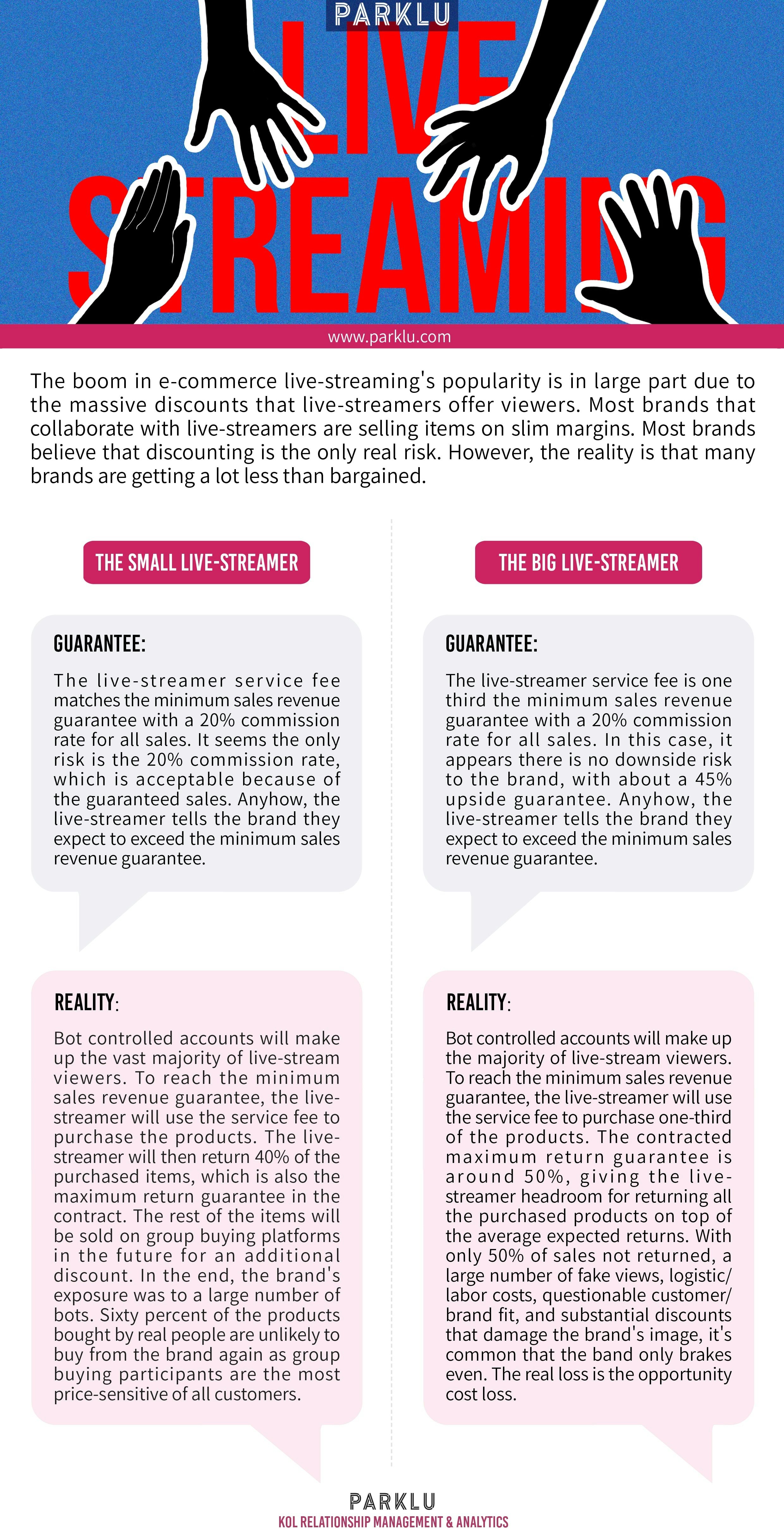This post originally appeared on PARKLU.com.
The allure of live-streaming e-commerce in China is undeniable, and the COVID-19 pandemic only amplified the trend. The format has exploded in popularity across all customer segments and demographics. Essentially, every major social platform now has live-streaming features with seamless e-commerce integration. Most brand marketers are salivating because star live-streamers are claiming to sell thousands of units in minutes. However, when something appears too good to be true, it probably is. So, we did some digging to uncover the live-streaming scams and struggles facing this emerging space.
Before we start, do you really believe that there is a pure win-win scenario taking place with live-streaming in China? Think about it. The platforms love live-streaming; it makes their ecosystems incredibly sticky, retaining users for hours at a time. The viewers get to watch an entertaining show and buy stuff (or watch bots buy stuff) for outrageously low prices. And the live-streamers (or their MCNs), well, they’re getting freaking rich. We believe it’s the brands that are sheep among wolves. Many brands are likely losing out in the long run, if not getting ripped off right upfront.
Live-streaming scams for brands#
Most brand marketers realize that after heavily discounting products, adding up fees and commissions, and factoring returns and logistics, most live-streaming campaigns are a financial wash. What marketers are paying for is mass awareness with target customers and low priced new customer acquisition. And the way to come out ahead is to have a very high retention rate of newly acquired customers…or so the theory goes.
The trouble starters with the “massive audiences.” The presence of bot accounts routinely inflates live-stream viewer numbers. This means that the baseline awareness that brands are expecting to generate among target consumers is fake. And unfortunately, it only gets worse from there.
It merely comes down to a lucrative game of arbitrage when a live-streamer is live-streaming for eight-plus hours a day and selling five-minute slots to brands. Live-streamers do not need to make their full contracted flat fee rate plus commissions to make a killing. The scam many live-streamers are running is getting paid to simultaneous buy and sell collaborating brands’ products. Whatever products a live-streamer can’t return, they sell on a 3rd party market place at a further discount. Obviously, this is not done by “the live-streamer,” but is a coordinated event with many people’s aid.
The lousy math of marketers is what is fueling these live-streaming scams. Live-streamers don’t even need to front the cash to buy the products in live-streams, they use brands’ upfront flat fee installments for that. Then considering the commission structure, ability to return purchases, and resell the rest, it’s the perfect hustle. And honestly, many marketers in the trenches don’t care because they get to hit the targets set by their bosses, and of course, the bosses are not diving deeper to understand the actual impact. It’s a scam, supported by laziness, guided by blind expectations.

It's a struggle for live-streamers too#
Being a successful livestreamer is tantamount to being a successful actor or signer. 1% of live-streamers are making a killing, 4% are making a living, and 95% are starving. Honestly, who wants to work 14 hours a day, 7 days a week, for years on end with no guarantee of success? And then, if you do succeed, it’s not like your an award-winning actor or signer; you are an online direct-response advertisement salesperson, which is quite a bit less sexy.
Live-streaming might look fun, even easy to the untrained eye. Armed with a phone, a tripod, and a cheerful manner, anyone can hit “go live” and become a live-streamer racking up millions of followers and sales, right? Wrong. One of the downsides of live-streaming in China is that it’s incredibly competitive. There is no such thing as an organic live-streaming star. Live-streamers are manufactured and the product of all manner of manipulation. Zhang Dayi’s affair scandal with the president of Alibaba’s Taobao and TMall is a testament to the dark side of how some KOLs’ success is made.
The predatory practices of MCNs are typically the only chance live-streamers have to be truly successful. Manage live-streaming at scale with a team and complex negotiations with brands, it’s not a reasonable expectation to become successful without support. And that’s not to mention the cash flow, tech, and people needed to pull off the live-streaming scams. Make no mistake, live-streaming is an industry with layers of intricacy that no girl or boy in their dorm room can pull off alone.

Live-streaming is often perceived as a goldmine for streamers, but the reality can be very different. By the time an MCN takes its cut of a deal, accounted for its overheads, and divided revenue up among all interested parties, there may not be much left over for the live-streamer, especially when you realize the model of live-streaming scams means that the revenue is very different from the fees and commissions charged to brands. The demands of livestreaming combined with a lack of compensation result in attrition and very high turnover within the industry – the vast majority of live-streamers that sign that with an MCN don’t last more than a year.
Avoiding live-streaming scams#
Marketers must be clear-eyed about how the livestreaming industry works. If there is a chance you’re getting screwed, you’ve probably already gotten screwed. The leverage brands have to protect themselves is mostly in the contract negotiation stage. Understand the costs, potential risks, and real opportunity. Be informed, create strategies that minimize risks, and have clear a path to genuine ROI.
